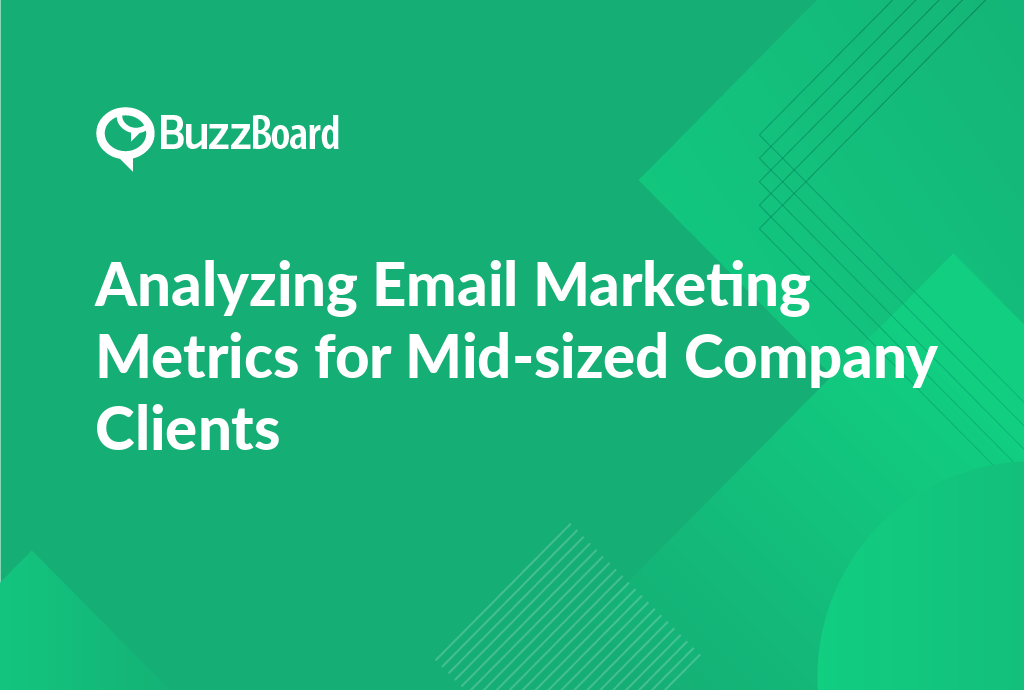The Importance of Analyzing Email Marketing Metrics for Mid-Sized Company Clients and How It Can Improve Their Overall Marketing Performance
Analyzing email marketing metrics for mid-sized company clients is a vital practice to significantly improve their overall marketing performance. The digital landscape is filled with data that, when used appropriately, can provide teams with key campaign insights to refine their strategies.
Email marketing metrics reveal your client’s campaigns’ performance, offering an important window into user engagement. It can show the open rates, Click-Through-Rates (CTR), and conversion rates. These are all critical elements in evaluating the effectiveness of the email marketing approach they’ve implemented.
Data analysis acts as a powerhouse for understanding these metrics. Through it, sales representatives at marketing agencies can pinpoint trends, identify prevalent anomalies, and implement real-time adjustments. A detailed focus on data-driven marketing can direct future campaigns toward greater success.
For mid-sized companies aiming to remain competitive, analyzing email performance isn’t simply an option; it’s a necessity. These businesses are filled with growth potential. Therefore, having a grip on their email marketing metrics can lead to more targeted, influential campaigns. Consequently, this can heighten customer engagement levels and retention, further powering their growth curve.
Remember, understanding data is crucial to discovering campaign insights; the clearer the insights, the better the performance.
Guide on Various Email Marketing Metrics That a Mid-Sized Company Should Track, and How to Analyze Them Effectively for Better Results
Analyzing email marketing metrics for mid-sized company clients is essential for understanding their campaign’s success and identifying opportunities for growth. Data analysis provides crucial insights into email performance, which can inform data-driven marketing strategies.
One vital email marketing metric for mid-sized companies is the open rate. This measure reveals how many recipients are actually opening the emails you send. The open rate serves as a primary indicator of your subject line’s effectiveness and overall email deliverability. Meanwhile, the click-through rate (CTR) monitors the percentage of users clicking a link in your emails, serving as a direct measurement of your email content’s success.
Another key metric is the conversion rate, which represents the percentage of users who completed a desired action (such as making a purchase or filling out a form) after clicking on an email link. This metric plays a significant role in determining the overall effectiveness of your email marketing campaign.
The unsubscribe rate should also be monitored. It gives you insight into the percentage of recipients who have chosen to stop receiving future emails. This metric serves as a tangible indicator of your content relevance and customer engagement.
Lastly, it’s worthwhile to track your bounce rate. This metric highlights the percentage of emails that couldn’t be successfully delivered to the recipient’s inbox.
To delve deeper into these metrics, consider using advanced email analytics tools. These tools offer refined campaign insights and help identify trends over time. Regularly checking these metrics and enriching your email marketing strategies based on these insights can vastly improve your clients’ business performance.
Remember, the effective measurement and analysis of email marketing metrics are fundamental to the continuous improvement of any digital marketing strategy. Your Email Analytics Tool can facilitate the analysis and enhancement of your email campaigns with robust data insights.
Successful Email Marketing Campaigns for Mid-Sized Companies, Highlighting the Role of Data Analysis and Deriving Useful Insights From Email Performance Data
Our first example is a women’s clothing brand that amplified its monthly revenue by 50% through a targeted email marketing campaign. After conducting a detailed data analysis, the company determined its target market had a pronounced inclination toward bespoke content. Capitalizing on this insight, they tailored the email content to mirror the browsing behavior and purchasing patterns of their customers. The outcome was an astounding boost of 50% in monthly revenue (source).
In a separate instance, an electronics retail company witnessed its open and click-through rates double following the implementation of data-driven marketing tactics. After closely analyzing its email marketing metrics, it noted that the subscribers were more inclined to interact with emails sent late in the afternoon. Consequently, the firm altered its email-sending schedule in alignment with these findings, leading to a significant surge in campaign performance
These examples underscore the significance of analyzing email performance data in devising successful email marketing strategies for mid-sized businesses. By routinely scrutinizing email metrics and developing actionable insights, companies can tweak their messaging to enhance customer interaction and drive up sales.
It is essential to remember that a comprehensive, data-driven strategy is at the core of every successful email marketing campaign for mid-sized businesses. To stay competitive, start incorporating data analysis into your email marketing regimen today.
Challenges Encountered by Mid-Sized Companies in Tracking and Analyzing Email Marketing Metrics, and Propose Solutions for Overcoming These Challenges
As sales representatives at digital marketing agencies targeting mid-sized companies, one frequently encounters hurdles in analyzing email marketing metrics for these clients. The data analysis complexities can often result in inaccurate interpretations and misguided campaign decisions.
Mid-sized companies, unlike small businesses, deal with larger sets of data, complex sales funnels, and a more diverse customer base. These factors can make the data analysis process difficult, posing a challenge in deriving meaningful insights from campaigns and accurately measuring email performance.
However, this should not prevent businesses from leveraging data-driven marketing strategies. There are solutions to overcome these challenges. For starters, investment in a robust analytics tool forms an essential first step. Such tools can automate the process of collecting and interpreting data, easing the burden on marketers and sales representatives. Moreover, agencies may consider hiring skilled data analysts for particularly complex campaigns.
Another viable solution would be to set specific goals for each email marketing campaign. A clear expectation of the metric that defines a campaign’s success can simplify the tracking and analysis process.
It’s important to remember that becoming proficient at analyzing email marketing metrics requires continuous learning and adaptation. To find out more about these solutions, and for help with implementing these strategies, contact us.
While every step might not always be easy, combining these strategies with rigorous review and adjustment undoubtedly leads to more effective email marketing campaigns. This enables mid-sized companies working with digital marketing agencies to reach their maximum potential and attain their business goals.
Remember, proper data analysis and utilization of email marketing metrics are not just nice-to-haves, but necessities for successful digital marketing in today’s highly competitive business landscape.
Projections on the Future of Email Marketing for Mid-sized Companies, Examining the Growing Importance of Data-Driven Strategies and the Ways in Which Detailed Analytical Reports Can Help Companies to Keep up With Shifts in Customer Behavior
The future of email marketing for mid-sized companies is brighter and increasingly data-centric. The shift from general email strategies to targeted, data-driven marketing is speeding up, heralding a new era of email performance optimization.
Analyzing email marketing metrics for mid-sized company clients now extends beyond basic open rates and click-through rates. Advanced data analysis tools let us dig deeper into campaign insights. We’re now capable of assessing customer engagement levels, buying habits, and website behavior post-click. These detailed metrics enable us to fine-tune our strategy, streamline our email design, and make informed data-backed decisions about the content that engages our audience best.
In today’s fast-paced digital world, mid-sized companies cannot afford to lag behind. Keeping up with shifts in customer behavior is vital, and data plays a crucial role in this process. Understanding who your users are, how they interact with your emails, and when they are most likely to convert can profoundly impact a brand’s bottom line.
This new approach isn’t just about accumulating data; it’s about extracting meaningful insights and predicting trends from this data. Hence, the growing emphasis on real-time analysis and data-led tactics in email marketing!
Engaging with an analytics service can provide projections and recommendations backed by rigorous data analysis, offering clear direction for future campaigns. Remember, our objective is to empower mid-sized companies to use data to fine-tune their email marketing strategy, regularly improving email performance and stimulating growth.
In conclusion, the future of email marketing for mid-sized companies will heavily depend on accurate and timely interpretation of email marketing metrics. As sales representatives, positioning yourselves to adeptly navigate these changes is vital in crafting success stories for your clients.









